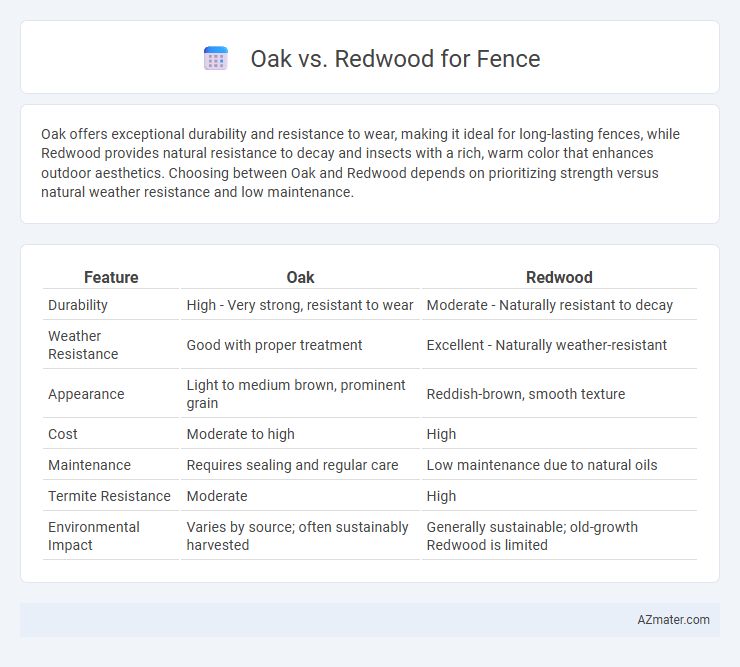Oak offers exceptional durability and resistance to wear, making it ideal for long-lasting fences, while Redwood provides natural resistance to decay and insects with a rich, warm color that enhances outdoor aesthetics. Choosing between Oak and Redwood depends on prioritizing strength versus natural weather resistance and low maintenance.
Table of Comparison
| Feature | Oak | Redwood |
|---|---|---|
| Durability | High - Very strong, resistant to wear | Moderate - Naturally resistant to decay |
| Weather Resistance | Good with proper treatment | Excellent - Naturally weather-resistant |
| Appearance | Light to medium brown, prominent grain | Reddish-brown, smooth texture |
| Cost | Moderate to high | High |
| Maintenance | Requires sealing and regular care | Low maintenance due to natural oils |
| Termite Resistance | Moderate | High |
| Environmental Impact | Varies by source; often sustainably harvested | Generally sustainable; old-growth Redwood is limited |
Introduction to Oak and Redwood Fencing
Oak fencing offers exceptional durability and strength, making it ideal for long-lasting outdoor barriers that withstand harsh weather conditions. Redwood fencing is prized for its natural resistance to decay and insects, providing a lightweight yet sturdy option with a rich, reddish hue that enhances curb appeal. Both materials ensure privacy and security while adding timeless aesthetic value to residential and commercial properties.
Wood Durability and Lifespan Comparison
Oak offers excellent durability with a lifespan of 30 to 50 years when properly maintained, making it resistant to rot and decay due to its dense cellular structure. Redwood, known for its natural resistance to insects and moisture, typically lasts 20 to 40 years, benefiting from naturally occurring tannins that enhance its longevity. Both woods provide strong options for fencing, but oak's higher hardness and density generally result in a longer lifespan compared to redwood.
Resistance to Weather and Insects
Oak offers strong resistance to weathering with a dense grain that withstands moisture and wind effectively, making it durable in various climates. Redwood naturally contains tannins and oils that provide superior resistance to insects and decay, reducing maintenance needs over time. While oak excels in structural strength, redwood outperforms in weather and insect resistance, making it ideal for outdoor fencing exposed to harsh environmental conditions.
Maintenance Requirements for Each Wood
Oak fences require regular sealing or staining every 2-3 years to protect against moisture and prevent cracking, as its dense grain absorbs water over time. Redwood naturally contains tannins that resist rot and insect damage, resulting in lower maintenance demands, typically needing only occasional cleaning and a light application of sealant every 3-5 years. Both woods benefit from proper installation and ventilation to extend longevity, with oak demanding more frequent upkeep to maintain its durability and appearance.
Appearance: Color, Grain, and Texture
Oak fences showcase a classic appearance with a warm, light-to-medium brown color that gradually darkens with age, featuring a prominent, straight grain and a coarse texture that highlights its robust character. Redwood fences offer a rich, natural reddish hue that ranges from deep crimson to soft pink-brown tones, combined with a fine, straight grain and a smooth texture that enhances its elegant look. The distinct color stability and smoothness of redwood make it particularly valued for decorative fencing, while oak's bold grain and texture provide a more rustic and durable aesthetic.
Cost Analysis: Oak vs Redwood
Oak fences typically cost between $20 and $30 per linear foot, offering a durable and dense hardwood option that is more affordable than redwood. Redwood fences average $25 to $40 per linear foot due to natural resistance to decay and attractive grain patterns, resulting in higher upfront investment but lower maintenance costs over time. Considering longevity and regional availability, oak often presents a lower initial expenditure, while redwood provides enhanced weather resistance that may reduce replacement and repair expenses.
Environmental Impact and Sustainability
Oak fences offer durability with a moderate environmental footprint due to its widespread availability and ability to regenerate in temperate forests, making it a sustainable choice when sourced responsibly. Redwood, naturally resistant to decay and insects, requires less chemical treatment, reducing environmental toxins; however, its slower growth rate and limited geographic range can raise concerns about sustainability. Choosing FSC-certified wood for either oak or redwood ensures better forest management practices, minimizing ecological impact while supporting sustainable fencing solutions.
Installation Considerations and Ease
Oak fencing requires precise installation due to its dense, heavy nature, demanding sturdy supports and corrosion-resistant fasteners to prevent splitting and ensure long-term stability. Redwood, being lighter and naturally resistant to warping and insects, allows for easier handling and quicker installation with standard galvanized nails or screws. Both woods benefit from pre-drilling holes, but redwood's softness significantly reduces labor time and tool wear, making it a more user-friendly choice for efficient fence building.
Best Use Cases for Oak and Redwood
Oak excels in fence construction for its exceptional strength and durability, making it ideal for heavy-duty applications and high-traffic areas where long-lasting support is essential. Redwood offers superior resistance to decay and insects, making it perfect for outdoor fences exposed to moisture and varying weather conditions. Choosing oak provides robust structural integrity, while redwood ensures longevity with minimal maintenance in damp environments.
Final Verdict: Choosing the Right Wood for Your Fence
Oak offers exceptional strength and durability, making it ideal for fences requiring long-term resilience against harsh weather and impact. Redwood provides natural resistance to decay and insects, combined with a rich color that enhances aesthetic appeal and requires less maintenance. For a fence balancing structural toughness and beauty, oak suits heavy-duty needs, while redwood is perfect for projects prioritizing longevity and visual warmth.

Infographic: Oak vs Redwood for Fence
 azmater.com
azmater.com